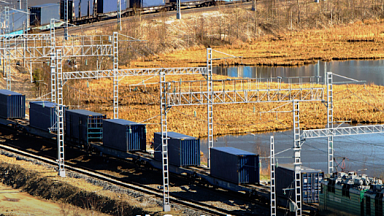The switch is necessary because the trains travel on broad-gauge tracks, which are mostly used in European and Central Asian countries, before entering China, where standard gauge tracks are used, Bai said. The trains, loaded with cargo including cars and car parts, household appliances and daily necessities, arrive at the station from different parts of China before continuing their journey to Europe. It is also the first stop for imported goods such as cotton yarn and timber, chemicals and electronic goods entering the Chinese market.
In 2022, a total of 6,211 China-Europe freight trains left and entered China through the port, according to local customs. As of November 3, 223.84 million tonnes of goods passed through the port, with a trade volume of 318.33 billion yuan ($43.61 billion).
This strategic port faces some unique challenges, as it experiences gale force winds for more than 180 days each year.
In the past, such conditions would have made outdoor operations almost impossible, Bai said, adding that the situation has improved drastically thanks to the port’s facility upgrades.
With the indoor transshipment yards, cargo on the China-Europe freight trains can now be transferred seamlessly at the port every day.
In 2017, the port was able to load about 700 to 750 containers per day, and now the daily transshipment capacity has increased to nearly 950 containers, Bai said.
«A lot of containers pass through my hands every day at Alataw Pass, and I feel honoured to be the gatekeeper of the vital BRI route,» he said.
The Alataw Pass Land Port is not just a transit point; it plays an important role in promoting trade and economic cooperation between China and Europe, said Li Jianglin, vice mayor of the border city of Alashankou.
As the largest land port in Xinjiang and an important channel for energy resources, Alataw Pass is the gateway with the shortest distance, fastest transit time and lowest freight costs on the Silk Road Economic Belt, Li said.





